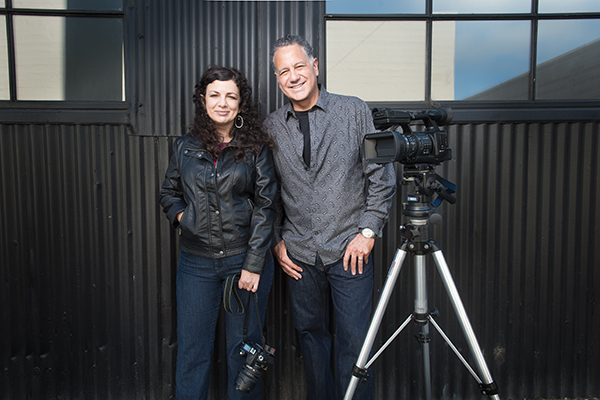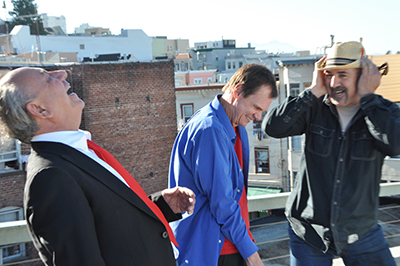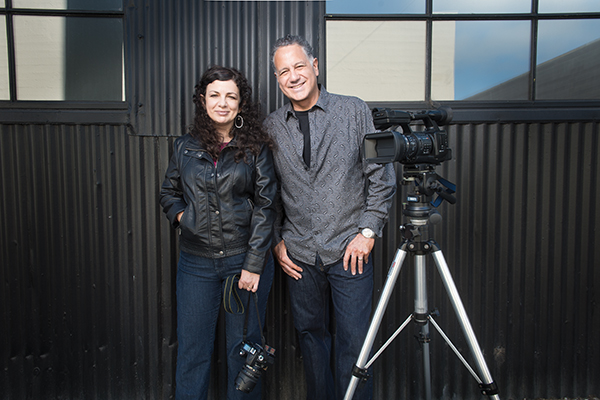
WHEN ROBERT CAMPOS picked up the phone last month and heard the words “We’d like your film to premiere in the Mill Valley Film Festival,” his quick affirmative response belied the years of work he and his partner/wife Donna LoCicero had invested in the project. While the San Francisco–based duo have been making documentaries for television for years from their Beanfield Productions office, this is their first feature-length documentary. Titled 3 Still Standing, the film explores the vibrant San Francisco stand-up comedy scene through the up-and-down careers of three comedians from the early 1980s to the present day. Here’s how the couple went from dabbling in the arts to debuting next month at one of the country’s most important film festivals.
How is it that you began making documentaries together? DL: We didn’t work together at first. I was a waitress and my degree was in city planning. But I enjoyed the conversation around the stories he was doing as a television journalist. RC: So we started working on some stories together. I could tell right away she had an affinity for storytelling. Better than anyone I had worked with before. She could look at these stories and figure out “We should talk to this person” or “We should talk to the mother.” How to make it better — that was always the challenge. When covering a story, you’re there for a short amount of time — in Argentina or wherever.
Argentina? DL: That was the first story we worked on: The children of the disappeared in Argentina. The government had taken students they considered radical and “disappeared” them. And, if those taken were pregnant, they would force them to have the children, then send the children out to be adopted. After that, because there’s DNA testing, the parents of the abducted students were looking for their grandchildren.
From there you did a story about hitchhiking across the United States, which turned into two TV series — one for ABC, Looking For America, I and II, and one for Bravo, TaleLights. What happened then? RC: Bravo ran out of money and I had left ABC to do TaleLights. We were on our own and decided to start our own production company. DL: We traveled all over the country covering eating competitions for the Food Network. Then we did a reenactment series called What Really Happened? And we did a piece on Dolly, the cloned sheep. RC: Discovery Channel called us up after those and asked if we would take on a story for Shark Week.
So where did you get the idea to look at the San Francisco comedy scene? RC: We both had been living here in the ’80s. We recently started talking about the comedy scene over dinner with our friend Tim Didion. DL: We both really enjoyed the scene. Dana Carvey at the Other Cafe. Robin Williams popped into the Holy City Zoo when I was there one night. It was also a way to reconnect to the city for us. So we decided to explore it. RC: We met up with Will Durst at San Francisco’s Comedy Day in 2010. And we saw Johnny Steele that day. Then Tim wanted us to meet Larry Brown and we started to get a sense that there was even more of a story here. Comedy was this amazing, eclectic thing in the ’80s, but then there was this kind of crash. DL: At first we thought it was just going to be a short piece. We thought this was just going to be our valentine to a scene we loved. But the more we talked to people, the more we realized it’s not just about what was — today’s scene is really interesting in a different way.
Will Durst, Johnny Steele and Larry Brown — what drew you to those three specifically? RC: It was largely serendipitous. But there really was something about Will, who does all that political comedy, and Larry is this kind of sad sack in the Steven Wright tradition — the other end of the spectrum — and Johnny is just a ball of energy. DL: Upbeat. Johnny uses his family stuff, which the others don’t do very much. His dad, his mom, and growing up in the East Bay, in Pittsburg. They’re three different points on the comedy spectrum and by looking at them we could look at the larger universe of the San Francisco comedy scene.
When you say “the San Francisco comedy scene,” it intrinsically includes the whole Bay Area. There was no complete scene without Marin, Concord, Fremont, Sunnyvale, and even all the way down into San Jose. DL: Yes! It was just that factor that allowed people to stay here, in the Bay Area, and make a living doing comedy. RC: Johnny talks about how he could hit four or five clubs in a night. There was an amazing plethora of venues and a community where you could walk in and do your set. Will and Johnny were both headlining at the time and that’s something that struck us: Oh, you can’t headline anymore. Because headliners are now people with TV deals and movie deals. So you headlined for 15 years and you’re a great comic but you don’t have a TV following. We felt these guys had so much in common with so many Americans who, for whatever reason, got their work outsourced or downsized.
One of the things that allowed you to connect with a lot of comedians for this project was Mark Pitta and Friends, a show that’s been going for more than 10 years on Tuesday nights at the 142 Throckmorton Theatre in Mill Valley. What was that like? RC: I think it’s great. Audiences’ tastes today are different and they call for a bit more. So that’s a viable model today — to have five people performing 20 minutes apiece. DL: The other thing about the Throck is that it’s created this atmosphere. It’s comedy-friendly. It’s just so important to comedians to be in front of an audience who’s smart and willing to explore different things. Comedians have told us it feels like home there.
Can you describe what “home” is to a comedian? A regular crowd like the Throck draws knows they’re going to get a good show, even if they don’t know the comedians. RC: Being part of that community of comedians where comics are willing to help other comics along. They’ll give each other a tag or a button for a joke. And only at a place like the old Holy City Zoo or the Throck does that happen. And I think it’s wonderful that the Throck has fostered this community of comedians who are there for the art of stand-up comedy. Another element no other club has is the fact that comedians like Robin Williams and Dana Carvey were comfortable dropping in from time to time. DL: The audiences at the Throck are responsive, forgiving, and smart. Robin told us over and over again how important it is to have a place to perform where you feel safe.
You recently got the word that 3 Still Standing has been accepted into this year’s Mill Valley Film Festival. Excited? DL: We’re over the moon about it. The more we think about it, the more we think it couldn’t be any more ideal. To be able to show it in Mill Valley, a place that really supports comedy, and a place where all of our guys can easily get to for the premiere, it just couldn’t be better. And it’s a wonderful festival. RC: We were so jazzed to get that phone call. It’s an amazing call to get. I answered the phone and it was Kelly Clement with the festival. He said, “I want to thank you for sending us such an upbeat film. I looked at all these films and this one made me laugh. We would love to have you premiere.” I almost cried. DL: It’s really quite a moment for filmmakers.
What They Say About Marin

WILL DURST (left) “Marin County audiences are the best audiences in the world — intelligent, comfortable with the live performance dynamic, and willing to poke fun at themselves. And, with a few exceptions, fairly good-looking. Long may they attend.”
LARRY BROWN (middle) “New George’s was the only Marin club during the boom of the ’80s that had any staying power. Now, the Throckmorton has been booming for 10 years, thanks to Mark Pitta. Big crowds, smart, a little too PC, but appreciative, with above-room-temperature IQs.”
JOHNNY STEELE (right) “I always love performing at the Throckmorton. The Mill Valley folks and I are very simpatico politically, intellectually and environmentally. The only drawback with working the Throck is the next night you might be booked in Turlock at Cooter’s House of Bacon and Idiocy and halfway through your set you hate them so much you just want to collapse into a heap and weep violently.”


